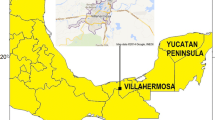Abstract
Background
The development of the city of Patras, including harbour relocation, in conjunction with the protection of the regional ecosystems, requires air quality assessment and management. For this reason, a model applicable in the Patras area is necessary and valuable. The goal of this study was to validate a model suitable for predicting the dispersion of sulfur dioxide (SO2), based on particular activity, topography and weather conditions.
Methods
We used the US-EPA ISCLT3 integral dispersion model to predict SO2 concentrations for Patras, Greece. We assumed that the major contribution to Patras air pollution came from central heating, harbour and traffic. We calculated traffic emissions using COPERTIII.
Results and Discussion
Assigning suitable values of the mixing height, the model predicted the local and spatial distribution of the mean monthly SO2 concentrations in downtown Patras, as well computed the contribution of the SO2 emissions originating from each particular source at each receptor location on a seasonal and annual basis. The comparison between predictions and measurements shows that the model performance for estimating the SO2 concentrations and period pattern is satisfactory.
Conclusion
The mixing height was the critical parameter for calibrating the model. Model validation promises satisfactory predictions for SO2 pollution levels on monthly basis.
Recommendations and Outlook
The model could be used in predicting SO2 concentrations and source contribution for several downtown Patras receptors using pertinent meteorological and emission information. It could be also extended to predict the dispersion of other primary air pollutants. The calibrated model predictions could be used to fill gaps in monitoring data, saving money and time, and help in assess and manage air quality as Patras develops.
Similar content being viewed by others
References
Delobbe L, Matthijsen J, Sauter FJ (2001): Evaluation of Mixing Height Representations in the EUROS Model. RIVM report 711002 001, National Institute of Public Health and the Environment, Bilthoven, Belgium
Gonzalez-Flesca N, Vardoulakis S, Cicolella A (2002): BTX concentrations near a stage II implemented petrol station. Environ Sci Pollut Res 9(3) 169–174
EPA (1995): User’s Guide for the Industrial Source Complex (ISC3) Dispersion Models. Vol. I — User Instructions, Vol II — Description of Model Algorithms. EPA-454/B-95-003a, b, September, 1995, Environmental Protection Agency, USA
EPA (2000): Meteorological Monitoring Guidance for Regulatory Modeling Applications. EPA-454/R-99-005, February 2000, Environmental Protection Agency, USA
Hanna SR (1987): An Empirical Formula for the Height of the Coastal Internal Boundary Layer. Boundary-Layer Meteorology 40, 205–207
Herman F, Smidt S, Huber S, Englisch M, Knoflacher M (2001): Evaluation of pollution-related stress factors for forest ecosystems in Central Europe. Environ Sci Pollut Res 8(4) 231–242
Klemm O, Lange H (1999): Trends of air pollution in the Fichtelgebirge Mountains, Bavaria. Environ Sci Pollut Res 6(4) 193–199
Kondrashov V, Reshetin V, Regens J, Gunter J (2002): Modeling mobile source emissions during traffic jams in a micro urban environment. Environ Sci Pollut Res 9(5) 333–336
Kreyszig E (1999): Advanced Engineering Mathematics. 8th ed., John Wiley & Sons, New York, pp 1125–1126
Luhar AK (1998): An analytical slab model for the growth of the coastal thermal internal boundary layer under near-neutral onshore flow conditions. Boundary-Layer Meteorology 88, 103–120
Ntziachristos L, Samaras Z (2000): COPERT III, Methology and emission factors (Version 2.1). Technical Report No. 49, November 2000, Copenhagen
Puxbaum H, Zambo E, Kalina M (1998): Assessment of wet, dry and occult deposition of sulfur and nitrogen at an Alpine site. Environ Sci Pollut Res, Special Issue 5, 55–58
Schnelle KB, Dey PR (2000): Atmospheric Dispersion Modeling Compliance Guide. McGraw-Hill, New York
Smidt S (1998): Risk assessment of air pollutants for forested areas in Austria, Bavaria, Switzerland. Environ Sci Pollut Res, Special Issue 5, 25–31
Syrakov D, Prodanova M, Ganev K, Zerefos C, Vasaras A (2002): Exchange of sulphur pollution between Bulgaria and Greece. Environ Sci Pollut Res 9(5) 321–326
Turner DB (1994): Workbook of Atmospheric Dispersion Estimates — An Introduction to Dispersion Modeling. Lewis Publishers, 2nd ed., CRC Press, USA
Yannopoulos PC, Skokaki GN (2003): Particulate and sulfur dioxide concentration measurements in Patras, Greece. J Air & Waste Manage Assoc 53, 957–970
Yannopoulos PC, Tzifa M-N V (2002): Dispersion of sulphur dioxide and particulate matter in the Patras air and the contribution of their sources to Patras downtown receptors. Environ Sci Pollut Res, Special Issue 3, 168–169
Author information
Authors and Affiliations
Corresponding author
Rights and permissions
About this article
Cite this article
Yannopoulos, P.C. Sulfur dioxide dispersion and source contribution to receptors of downtown Patras, Greece. Env Sci Poll Res Int 14, 172–175 (2007). https://doi.org/10.1065/espr2006.06.319
Received:
Accepted:
Published:
Issue Date:
DOI: https://doi.org/10.1065/espr2006.06.319




